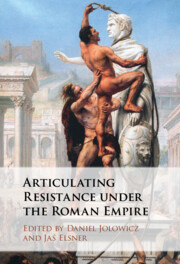Book contents
- Articulating Resistance under the Roman Empire
- Articulating Resistance under the Roman Empire
- Copyright page
- Contents
- Contributors
- Acknowledgements
- Abbreviations
- Introduction Articulating Resistance
- Part I Language and Identity
- Chapter 1 Linguistic Resistance to Rome
- Part II Genres of Literary Resistance
- Part III Identity Negotiation
- Part IV Religion and Resistance
- References
- Index
Chapter 1 - Linguistic Resistance to Rome
A Reappraisal of the Epigraphic Evidence
from Part I - Language and Identity
Published online by Cambridge University Press: 23 December 2022
- Articulating Resistance under the Roman Empire
- Articulating Resistance under the Roman Empire
- Copyright page
- Contents
- Contributors
- Acknowledgements
- Abbreviations
- Introduction Articulating Resistance
- Part I Language and Identity
- Chapter 1 Linguistic Resistance to Rome
- Part II Genres of Literary Resistance
- Part III Identity Negotiation
- Part IV Religion and Resistance
- References
- Index
Summary
The use of local languages is sometimes considered a marker of resistance to Roman power or culture. However, we show that continued use of local languages cannot necessarily be equated with resistance, nor is it easy to identify the use of language or script in particular inscriptions as driven by a desire to express resistance. This chapter discusses how (and whether) it is possible to know when resistance is involved in language use in the Roman Empire and examines case studies of inscriptional evidence pertaining to the use of Faliscan, Oscan, Paelignian, Venetic, Celtiberian, and Hebrew. We propose that many of them were written to present a ‘non-Roman’ rather than an ‘anti-Roman’ identity, and that ‘non-Roman’ identity could stand alongside both acceptance of Rome and violence resistance to its political hegemony.
- Type
- Chapter
- Information
- Articulating Resistance under the Roman Empire , pp. 29 - 48Publisher: Cambridge University PressPrint publication year: 2023

